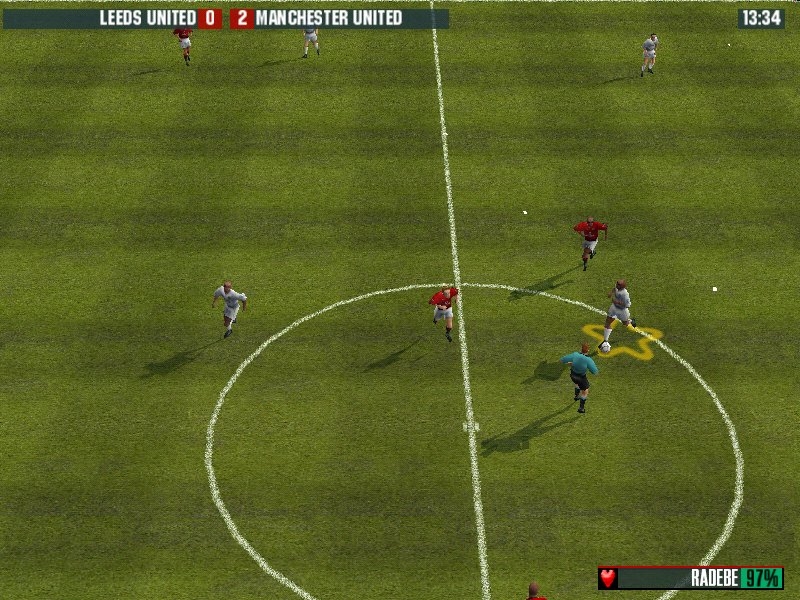
The F.A. Premier League STARS 2001
Written by: Rik
Date posted: March 21, 2021
- Genre: Sport
- Developed by: Electronic Arts
- Published by: Electronic Arts
- Year released: 2000
- Our score: 5
Football history seems like a source of unexplored potential for the gaming world. 1998’s journey through the World Cup’s past, Viva Football, was a pretty terrible game, but the idea was good enough to be worth revisiting. These days, though, there would likely be complicated licensing issues to be negotiated, in order to recreate old players, teams and events in any kind of detail.
Plus, it’s all a bit more complex than simply whacking ye olde kits onto modern FIFA, because the sport itself has changed over the years. While old football games were more simplistic affairs largely due to technological limitations, the style of football they were attempting to replicate was also less sophisticated. To some small extent, the ping-pong style of the likes of Kick Off 2 and Sensible Soccer reflected the direct style of play at the time. The latest FIFA is complicated, but arguably so is modern football. Do teams even play with two up front anymore? [No – FFG reader].
Having said that, I still think that there’s something in the idea. As a veteran of a lot of old football titles, very few actually conjure the feeling of being transported back to a certain period in football history. Occasionally it does happen: Manchester United: The Double is the mid-90s Premier League in a nutshell, while UEFA Champions League 01/02 takes you back to watching terrestrial coverage of early-00s midweek European fixtures. For all that they remain rather primitive and outdated games of computer football, they still deliver something that you can’t get from the latest titles.
Despite its status as a defunct and short-lived spin-off from EA’s main football series, The F.A. Premier League STARS has the same potential to take the player back in time. Coming at a point when FIFA was still delivering a fairly generic experience, STARS was a project that was very clearly designed to recreate the look, sound and feeling of Premier League football, as experienced by fans at the time, as closely as possible.
Without wanting to repeat what I said here, it has to be noted that, like it or not, such a prospect was very exciting to the game’s target market. To go beyond the world of generic kits, competition names and stadia that were on offer in most other football titles, including EA’s own, and create an authentic virtual facsimile of a particular Premier League season, was something that would be worth paying for, almost like an official World Cup tie-in. You could almost overlook the fact that the game itself was rather flawed and uneven. Almost.
As an ongoing franchise, there was a dilemma for EA: do we actually want this to be better than FIFA? And how can the two series coexist? The answers they ultimately came up with were: we don’t, and they can’t. However, the first game was clearly successful enough to get a single annual update, which is the 2001 edition that we’re looking at here.
Let’s start with the presentation, as it’s the main selling point. Slightly choppy resolution and basic player models aside, STARS 2001 still looks pretty good. Kits are accurate for the 00/01 season, with sponsors, kit makers and badges all present and correct, while official Premier League numbers adorn the back of shirts. Meanwhile, each stadium is recreated in detail, right down to the advertising hoardings, and players are cheered on with team-specific chants and songs.
Added to that, the full Sky commentary line-up is at EA’s disposal, with the since-disgraced duo of Richard Keys and Andy Gray joining Martin ‘Puma World Football‘ Tyler for voice-over duties. This is clearly an attempt to replicate the Sky Sports coverage of top division football in all but name: Keys even welcomes you to ‘Super Saturday’, which is extremely close to the name of Sky’s flagship live football programme. Substitute ‘Sky’ for ‘EA’ and it could almost be an official tie-in.
The game is structured around a Premier League season, with the usual control over squad selection and tactics bolstered by a very light-touch management element that revolves around the earning of the titular STARS, which act as in-game currency to be invested in the team, either by boosting the stats of your existing players, or by delving into the transfer market.
It’s fairly low maintenance stuff, and basically amounts to making regular decisions about the best way of allocating your earnings across the squad, with 10 largely self-explanatory categories to choose from for each player. Experienced retro-gamers will know that certain fundamentals such as pace, passing and shooting for your attacking players represent a wise investment in the first instance, although stamina is also worth considering in order to avoid the need for heavy squad rotation.
Generally, though, STARS 2001 does rather seem to be geared in favour of player replacement, with those on the transfer list usually significantly better than your own squad and available for roughly the cost of two or three decent wins. In fact, as is the case with all players on opposition teams, the players on the list get better as the season progresses with no effect on their price tag, and presumably this is all part of the calculation for you to make, in terms of when to make a move. (This game predates the concept of a real-life Premier League transfer window, natch).
The selection of transfer-listed players is fairly static, and not particularly rooted in reality, presumably to allow for fairly surface-level schoolboy fantasy transfers to be fulfilled. Indeed, Newcastle and England’s Alan Shearer (ironically, part of a real-life ‘dream’ strike partnership with Duncan Ferguson around this time that would work fine in the likes of this game but not in reality) was available throughout my season for a thoroughly reasonable number of STARS.
If you have some loyalty to your existing players, then it can seem a bit ‘off’ to replace them at random, despite the affordability and impressive stats of the interlopers. I guess it depends on your chosen team: at that point my Leeds squad had the likes of Smith, Kewell and Bridges available, and an ageing Shearer hardly fitted the youthful mould of the David O’Leary era. (Having said that, the availability of high-profile players from non-English teams was tempting, and my resolve did break later in the season when I bolstered the squad with some overseas superstars). The transfer process itself is a bit bizarre: you can miss out while bidding on a player to other clubs, but then they don’t actually join those clubs: they stay on the list and you can try and buy them again, either immediately, or at a later date. The game does only last for a single season, so there’s no building for the future: short term considerations are the only ones that matter.
To get STARS in the first place, you have to perform on the pitch, and goals and wins are the most obvious earners. Less obvious is why Man of the Match is worth the same number of STARS as a win, or indeed how this award is determined, as for my players, scoring a hat-trick in a big victory was often deemed insufficient for the honour, which would instead go to someone on the losing side. You can also earn points for scoring a spectacular goal, known as a STAR goal, but these are tricky to pull off, as the system for long-range shooting requires a large amount of time to hold down the button and bring up a power gauge, whereas a tap unleashes a reasonably effective one in an instant. (I instead favoured grinding out wins through more reliable scoring methods, such as from corners, which are similarly effective here as in FIFA 2000, or by creating a one-on-one with the ‘keeper.)
Time on the ball is at a premium, and STARS lacks the shielding feature introduced in FIFA 2000. You also don’t have access to a pitch scanner which makes you reliant on educated guesses when it comes to passing, and the use of a zoomed-out camera is recommended. However, it’s still a little less harum-scarem than FIFA 2000, and some thoughtful passing moves are still possible, while the tricks and skill moves are more risky and therefore more satisfying to pull off than in FIFA, in which regular pirouetting around opposition players soon became necessary and routine.
Indeed, although it’s been a long time since I played either of them, this feels more like FIFA ’98 or World Cup ’98 than FIFA 2000, as if the ingredients for those games were given to two teams a couple of years ago and one went off to progress the FIFA series while the other was left with STARS. There is something lumpy and uneven about the action here, particularly in defence, as your backline often parts like the Red Sea without explanation, with control taken from you at crucial moments, allowing opposition strikers to warp into the box unchallenged. And at other moments there is cause to lament missing features that are present in its older sibling.
However, I did like the on-pitch action a little more than in FIFA 2000. While there are signs of the iffy physics that came to dog the main FIFA series in the 00s, here the ball still feels like it’s round and something that rolls along the turf, while shots feel more realistic and satisfying than in FIFA, particularly when they hit the net. Meanwhile, the STARS system does add something to the season mode, and though the effect of your investment of STARS may not seem immediate, in that new or improved players don’t suddenly start controlling the game on their own, it is possible to notice improved performances, particularly from attackers with improved shooting and control stats. And on top of that, you do have the additional sense of atmosphere and authenticity provided by the additional presentation perks.
Having said that, it is possible to wonder at some missed opportunities to develop this aspect of the game still further: for example, by showing the team line-ups and formations beforehand, varying the commentary depending on the league position of the two teams, or improving the player models a little more. (And it’s a nit-pick, I know, but the numbers for some shirt colours should be white: they’re uniformly black here).
A further anomaly is the inclusion of competition on the European and world stage, which seems unnecessary, and sees ITV’s Clive Tyldesley coming into the commentary box in place of Martin Tyler, presumably to reflect the fact that ITV, not Sky, showed European football at the time (although Keys and Gray are still featured, so it undermines the sense of realism somewhat). Also, opposition kits and stadia are not fully licensed (despite Spanish, Italian and German counterpart versions of STARS all being produced) and so you end up playing against generic Barcelona in what looks like a non-league ground. If you make it to a European final, it’s held at a realistic-looking old Wembley, which is a nice touch, even though this was the season in which real-life matches stopped being played there.
STARS 2001 is a curious product then: one that feels slightly tired and redundant on the one hand, while still boasting some of the flash that made it stand out, however briefly. As an ‘event’ product, it still succeeds in recreating the feeling of early 2000s Premier League TV coverage (even down to the thumping house music, courtesy of Ministry of Sound), while on the pitch, it may be a slightly-faffed-about-with version of an older FIFA game, but it remains marginally more enjoyable than the main series equivalent available at the time. So, as a one season exercise in nostalgia, there’s something here worth exploring for the ageing footy fan.

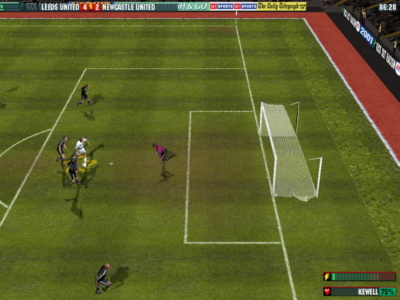
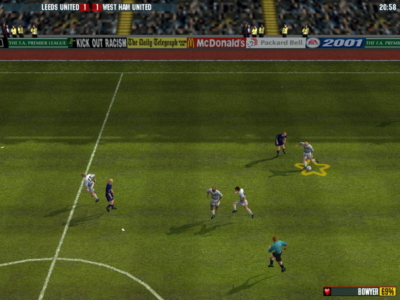
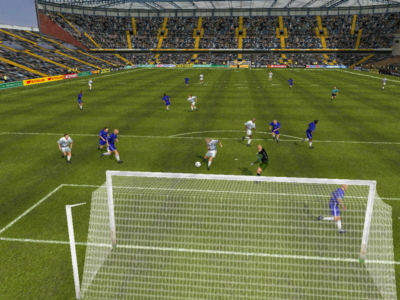
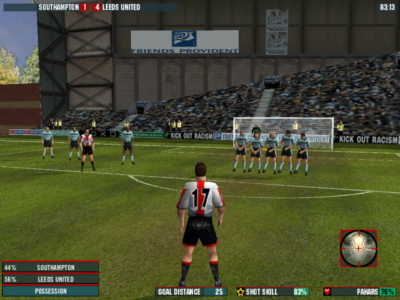
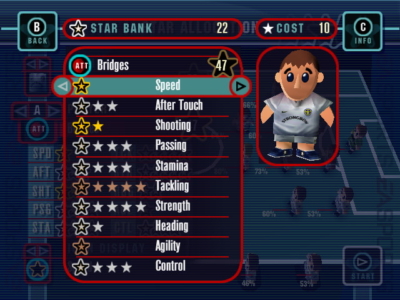

 Posts
Posts